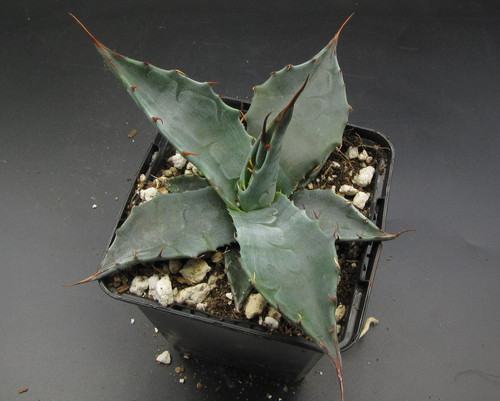Pot Size: 3.5"
Recommended Temperature zone USAD: 6b - 11
Frost Tolerance: 0.c
Minimum Avg. Temperature: 10.c
Sun Exposure: Full sun
Origin: Northeast states of Tamauilipas, Nuevo Leon, and Querataro, Mexico.
Height: 4'
Width: 5'
Growth Rate – Shape: Slowly growing rosette.
Watering Needs: Regular water in summer, dry in winter
Flowers: Yellow flowers on 15' stalk
Agave montana, commonly known as the "Mountain Agave," is a strikingly architectural succulent native to the high-altitude regions of northeastern Mexico. This evergreen perennial is prized for its symmetrically rosette-shaped form and dense, rigid leaves with finely serrated edges. The foliage typically features a bluish-green hue, often highlighted by white bud imprint patterns along the leaf margins. Mature specimens can reach a diameter of 3–4 feet (90–120 cm), making it a medium-sized agave well-suited for greenhouse and indoor environments.
Growth Requirements
-
Light
Agave montana thrives in bright, indirect sunlight. For indoor settings, position the plant in a south- or west-facing windows to maximize light exposure. In greenhouses, ensure light levels of approximately 10,000–12,000 lux to replicate its natural high-altitude habitat. Use supplemental grow lights in low-light conditions.
-
Temperature and Humidity
- Optimal temperatures range between 15–29°C.
- Although tolerant of cool temperatures, prolonged exposure below -4°C may damage the plant.
- Prefers low to moderate humidity levels; avoid excessive moisture to prevent fungal issues.
-
Watering
- Water sparingly, allowing the substrate to dry completely between watering cycles.
- Overwatering is a common issue in indoor environments; ensure proper drainage. During dormancy in cooler months, reduce watering significantly.
-
Soil
Use a well-draining cactus or succulent potting mix. Amend standard potting soil with sand, perlite, or pumice to ensure adequate aeration and mimic its native rocky soil conditions.
-
Fertilization
Feed every 2-3 weeks during the active growing season (spring and summer) with a diluted, low-nitrogen fertilizer. No fertilization during dormancy.
-
Pot and Repotting
- Choose a container with ample drainage holes.
- Repot every 2–3 years or when the plant outgrows its pot. Handle the sharp leaf edges carefully during this process.
-
Pest and Disease Management
- Common Pests: Mealybugs, scale insects, and spider mites. Regularly inspect leaves and use insecticide or neem oil as needed.
- Diseases: Root rot due to overwatering is the primary concern. Prevent by maintaining proper soil drainage and avoiding waterlogging.
Propagation
Agave montana propagates primarily through offsets (pups) that emerge around the base of the plant. Separate pups with a sterilized knife and allow the cut to callus before planting in fresh soil.







